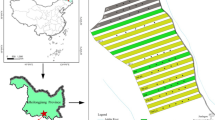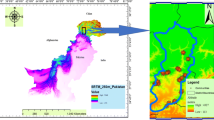Abstract
This study was carried out for the purpose of detecting the relationship between soil-inhabiting tardigrade communities and environmental factors of various forests. Nine forests in the southern part of Kanagawa Prefecture, Central Japan, were selected for this study. Four vegetation types were designated; broadleaved (evergreen/deciduous), coniferous and orchard. In these sites, dry weight of leaf litter, soil pH, soil hardness, soil moisture content and porosity ratio were measured. Wet soil faunal frequencies were also described. The Baermann funnel method was adopted for collecting tardigrades, and DIC microscopy was used for specific identification. To clarify the correlation between environmental variables and tardigrade faunae, multivariate analysis was applied.
The tardigrade fauna occurred as two distinct groups. The first group primarily contained Macrobiotus species. The second group contained the genus Diphascon (e.g. D. nobilei, D. patanei, D. prorsirostre). An exception to this was D. pingue, included in the former. Most of the Diphascon species were concentrated in Nebu (coniferous forest site), while, Macrobiotus species were dominant in other sites. Distinct environmental factors could not be identified, but the nematodal frequency was recognized as the main factor in forming these groups. The uniqueness of Nebu, which does not correspond to large-scaled vegetational classification, was substantiated by statistical data. Nebu’s coniferous forest apparently has created a unique environment for sustaining rare species (Diphascon species). This study concluded that forests should be evaluated not only by the macroscopic factors, such as landscape, but also by the microscopic communities, such as those including the tardigrades.
Similar content being viewed by others
References
Araki, M., 1999. The method of soil physical analyses using cylindrical core sampler. Forest site research method editorial committee (ed.) Forest Site Research Method. Hakuyusha Publication. Tokyo: 33–36. (in Japanese)
C. C. Doncaster D. J. Hooper (1961) ArticleTitleNematodes attacked by protozoa and tardigrades Nematologica 6 333–335 Occurrence Handle10.1163/187529261X00199
J. W. Fleeger W. D. Hummon (1975) ArticleTitleDistribution and abundance of soil Tardigrada in cultivated and uncultivated plots of an old field pasture. Memorie dell’Istituto Italiano di Idrobiologia Dott Marco di Marchi 32 93–112
R. Guidetti R. Bertolani D. R. Nelson (1999) ArticleTitleEcological and faunistic studies on Tardigrades in leaf litter of beech forests Zoologischer Anzeiger 238 215–223
T. E. Hallas G. W. Yeates (1972) ArticleTitleTardigrada of the soil and litter of a Danish beech forest Pedobiologia 12 287–304
M. T. Hutchinson H. T. Streu (1960) ArticleTitleTardigrade attacking nematodes Nematologica 5 149 Occurrence Handle10.1163/187529260X00514
M. Ito (1995) The classification, distribution and community analysis of soil wet fauna in the main forests of Kanto region Newsletter of forestry and forest products research institute Japan 583
M. Ito (1999) ArticleTitleEcological distribution, abundance and habitat preference of terrestrial tardigrades in various forests on the northern slope of Mt. Fuji, central Japan Zoologischer Anzeiger 238 225–234
M. Ito W. Abe (2001) ArticleTitleMicro-distribution of soil inhabiting tardigrades (Tardigrada) in a sub-alpine coniferous forest of Japan Zoologischer Anzeiger 240 403–407
Y. Itô K. Sato (2002) ArticleTitleProblems around the indices of species diversity for comparison of different communities Biological Science 53 204–220
K. I. Jönsson (2003) ArticleTitlePopulation density and species composition of moss-living tardigrades in a boreo-nemoral forest Ecography 26 356–364
R. D. Kathman S. F. Cross (1991) ArticleTitleEcological distribution of moss-dwelling tardigrades on Vancouver Island, British Columbia, Canada Canadian Journal of Zoology 69 122–129
Kitazawa, Y., 1972. Seasonal and yearly changes in the number of soil animals other than Nematoda extracted by the Baermann funnel of the subalpine coniferous forest ecosystem of Mt. Shiga, IBP area, Central Japan. JIBP synthesis, biological productivity of subarctic and temperate ecosystems — the report of 1971 (Showa 46th) I: 177–180. (in Japanese)
Nelson, D. R., 1975. Ecological distribution of tardigrades on Roan Mountain, Tennessee – North Carolina. In Higgins, R. P. (ed.), Proceedings of International Symposium on Tardigrades. Memorie dell’Istituto Italiano di Idrobiologia. Dott. Marco di Marchi Supplemento No. 32: 225–276
ter Braak, C. J. F. & P. Smilauer, 1998. CANOCO Reference Manual and User’s Guide to Canoco for Windows: Software for Canonical Community Ordination (version 4): Microcomputer Power. Ithaca: 15–177
Author information
Authors and Affiliations
Corresponding author
Rights and permissions
About this article
Cite this article
Harada, H., Ito, M.T. Soil-inhabiting Tardigrade Communities in Forests of Central Japan. Hydrobiologia 558, 119–127 (2006). https://doi.org/10.1007/s10750-005-1410-z
Issue Date:
DOI: https://doi.org/10.1007/s10750-005-1410-z




